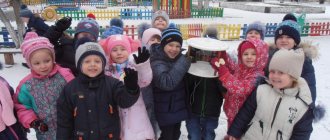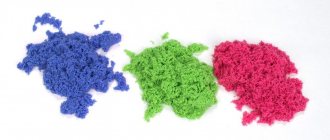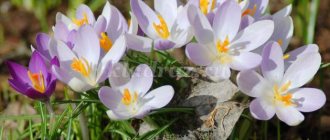Municipal budgetary preschool educational institution, kindergarten of general developmental type No. 11 “Firefly” of the Municipal Entity Timashevsky District (MBDOU d/s No. 11) was opened in 1966.
If there is an island of love, joy, and happiness on Earth, then this is MBDOU d/s No. 11 “Firefly”. Our preschool educational institution is a living organism that breathes, feels, and rejoices. We try to penetrate every child's heart, instill in it joy, love, kindness. Preschool educational institutions are parents. They are the main assistants in our work and we are very grateful to them for this. Preschool educational institutions are employees. The most hardworking, creative people who can do everything, who care about everything with their souls, who love children. A preschool is a big family. And like any friendly family, we have our own traditions. If you want your baby to feel comfortable, to develop in accordance with his capabilities and abilities, come to us at the Firefly kindergarten.
The preschool educational institution operates in accordance with the Federal Law “On Education in the Russian Federation”. A license was issued for the right to carry out educational activities under educational programs dated March 12, 2013 No. 05353. The preschool educational institution has a license to carry out medical activities dated December 5, 2012 No. LO-23-01-005240.
The preschool educational institution ensures a high level of development of preschool children in accordance with their age and individual characteristics. Contributes to the preservation of physical and mental health, intellectual, artistic and aesthetic, social and moral development, emotional comfort of the child and his socialization.
The preschool educational institution works according to the “Basic general educational program of preschool education.”
In addition to the basic forms, teachers use new methods, technologies, and partial programs in their work:
- “Education of ecological culture among preschool children” (S.N. Nikolaeva)
“Fundamentals of the safety of preschool children” (R.B. Sterkina,)
MAIN TASKS OF EDUCATION AND TRAINING IN KINDERGARTEN:
- protecting the lives and strengthening the physical and mental health of children;
- ensuring the intellectual, personal and physical development of the child;
- introducing children to universal human values;
- interaction with the family to ensure the full development of the child.
PRIORITY DIRECTIONS:
- protecting the lives and strengthening the physical and mental health of children
- artistic and aesthetic education of children;
- interaction with the family to ensure the full development of the child.
The teachers will make sure that your child becomes independent, sociable, active, inquisitive, learns to think, develops his creative abilities, joins the world of art, and learns to create his own artistic creations; musical director L.E. Chernyavskaya will reveal the talents of your baby and he will become a real little artist; work on moral and patriotic education is carried out, skills and abilities in visual arts are improved, taking into account the age characteristics of children. Work is underway on environmental education in all groups, there is an environmental classroom “Ladybug” in which senior students conduct experiments and experiments, based on the developments of the programs “Young Ecologist” by S.N. Nikolaeva and “Our Home is Nature” by N.A. Ryzhova. Children develop a conscious attitude towards natural phenomena, towards themselves and their health. At the preschool educational institution a complex of health-improving and educational activities is carried out, the basis of which is motor activity, these are: physical education classes; physical education and health work during the day (morning exercises, physical education minutes, outdoor games and physical exercises, hardening activities, gymnastics after sleep, “health paths”); active recreation (physical education and holidays, health days, vacations); health services: phytoncidotherapy.
We provide additional development of children’s individual abilities in the “Bell” - vocal circle.
Pedagogical principles of the team:
We raise friendly, cheerful and resourceful people. We warm you with affection, warmth, care. We develop healthy, strong, dexterous people. We sow reasonable, good, eternal things.
Every child in our garden is a clear star. And this star shines brighter because she knows that she is loved and valued, knows that she will not be abandoned, but will be helped to achieve perfection.
Dear mothers and fathers, grandparents!
We are glad to welcome you to our website!
Why did we open our website on the Internet?
In order to tell more about the preschool institution, which has become a second home for us, about the kind and creative employees who give a piece of their soul and warmth to our dear students, as well as about the children themselves, whose upbringing and education we consider the most important activity. We strive to ensure that the preschool educational institution is for everyone who visits it a home in which comfort, coziness and kindness reign, where music and sonorous children's laughter are heard, a home to which they come with joy.
On this website you can get all the necessary information about the life of our kindergarten.
You can find out information about how we live. We will talk about past events and significant dates. You can look at our photo album and learn from us some experience in conducting classes and consultations.
- In the “Guest Book” section you can contact us and leave wishes and comments on the work of the preschool educational institution in general, as well as get acquainted with the opinions of other parents;
- The “Kindergarten Events” and “News” sections contain notes of classes and events conducted by our teachers;
- The “Garden Tour” section contains photographic materials of the territory of the preschool educational institution, interesting events held in the preschool educational institution, etc.;
- In the “Information for Parents” section you will find a lot of interesting things: games, poems, songs, riddles and much more;
- In the “Recommendations from Experts” section you can find consultations for educators and parents.
We hope that our site will be useful to both parents of pupils of our preschool educational institution and many others. If you have questions regarding MBDOU d/s 11, you can ask them to our email address.
We are waiting for you at:
Krasnodar region, Timashevsk microdistrict. Sugar factory 8.
tel./fax: 8 (86130) 5-35-77
Sincerely, Head of MBDOU d/s No. 11 Avramenko Tatyana Andreevna
Pedagogical project in the middle group of kindergarten on the topic: Feed the birds in winter
Pedagogical project in the middle group on the topic: “Feed the birds in winter.”
This project will be useful for teachers of preschool children, additional education teachers, and pedagogical students. Project name: “Feed the birds in winter” Author : teacher of the middle group of the kindergarten “October Kindergarten” Tatyana Leonidovna Vasilkova. Duration of the project : short-term 2 weeks from November 11 to November 28. Type of project : educational, informational, productive. Project participants : children, parents, teachers. Children's age : 3-5 years. The problem is significant for children, the solution of which the project is aimed at: Forming in children elementary ideas about wintering birds of their native land. In our case, the Kaluga region. Children have not developed knowledge about the names of birds, wintering and migratory birds. Children have a small amount of knowledge about the habitat of birds, why they need to take care of them in winter, and how they themselves can help the birds. Relevance of the project : 2021, by decree of our President V.V. Putin, was declared the Year of Ecology in Russia. In the rapidly developing modern world, the problem of environmental education of modern preschoolers is becoming especially acute and relevant. After all, it is in this sensitive period that preschoolers develop their personality, and it is important during this period to have time to form love and care for living nature, to learn to take care of the world around them. Knowledge about the world around us acquired in preschool childhood arouses in children a deep, sincere interest in it, expands knowledge, contributes to the formation of character and love for living nature. Also, during the cold season, there is less and less food for birds, as a result they may even die, which cannot be allowed! The task of adults (teachers, parents) is to cultivate interest, care, a desire to learn new facts about their lives, to experience the joy of realizing that they themselves can, by sharing crumbs, save birds from death. Project goal : To form children's understanding of wintering birds, their lifestyle, and what to feed them. Create conditions for the development of cognitive interest. Project objectives: Educational : To give children an idea of the wintering birds of their native land (Kaluga region). Expand and deepen the knowledge of preschoolers on the topic: “The life of birds in winter” Activate children’s vocabulary with terms from the project topic. Developmental: Develop thinking, memory, fine motor skills, coherent speech. Develop creative abilities in productive activities. Develop curiosity and interest in living nature. Educators: Foster a caring attitude towards birds, a desire to help them in difficult cold conditions. Cultivate friendly relations in the children's team. Promote the formation of interest in the world around us. For the teacher: A. To give children knowledge about wintering birds of the Kaluga region. B. Develop curiosity, “living” interest. B. Expand children’s knowledge of wildlife, the habitat of wintering birds and their way of life. D. Develop children's creative abilities. Expected result : A. Improve the level of children's knowledge about the world around them, about wintering birds. B. Formation of a caring attitude towards living nature in children. B.Increasing the level of knowledge of parents. D. Making bird feeders by parents. D. Showing interest and interest of children together with their parents in caring for birds and the desire to help them in the winter. Product of the project activity : A. Performing collective work in non-traditional mixed media (Painting with a palm, a cotton swab and an imprint of a plastic cork) with paints: “Bird's Canteen” B. Drawing with gouache: “Bullfinch” C. Presentation “Migratory and wintering birds” D. Folder -movement “November 12th Titmouse Day” D. Plasticineography “Bullfinch on a Rowan Branch” E. Making a feeder from a toilet paper roll. E. Decorating patterns of bullfinch, titmouse, sparrow. G.Applique bullfinch. 3. Parents making bird feeders. I. Modeling a sparrow. Project implementation: Preparatory stage : A. Determine the topic of the project. B. Formulate the goals and objectives of the project. B. Draw up a project implementation plan. D. Selection of visual and informational material for the implementation of the project. D. Selection of material for productive activities. Main stage . A. Examination of illustrations and books on the topic of the project. B. Conducting a GCD on the surrounding world: “Birds of the native land” B. Conducting a GCD on the surrounding world: “November 12th Titmouse Day” (as a result of the lesson, the children made mini-feeders from waste material) D. Conducting a GCD on HER application topic : “Bullfinch” D. Carrying out GCD JSC KHER gouache painting: “Bullfinch” E. Carrying out GCD in music with listening and learning the song “Sparrow” J. Viewing the presentation: “Migratory and wintering birds” H. Learning a poem: E. Evseeva Tit, tit, what are you dreaming about? I. Conducting finger gymnastics: “A snowflake sat on a branch...”, “I’m knocking on wood...” K. Consultation for parents: “How and from what you can make a feeder” L. Conducting a competition for families of pupils to make feeders: “Feed birds in winter" M. Carrying out GCD on HER plasticineography "A bullfinch on a rowan branch. The final stage. A. Performing group work in non-traditional mixed media (Painting with a palm, a cotton swab and a print of a plastic cork) with paints: “Bird's dining room” B. Conducting educational activities around the world: “How can we help wintering birds?” B. Summing up the results of the feeder competition. D. Hanging feeders. We hung one feeder outside the window of our group. D. Observing birds at feeders. Result. As a result, the work turned out to be voluminous and informative. Project activities are planned taking into account the integration of areas, helping children to master and comprehend new knowledge. Which were given to them by their parents and teachers. Expanding your horizons and ideas about wintering birds. The general level of children's knowledge about the world around them has increased. Children acquired specific knowledge about living nature. They began to share the information they received with other children! Parents became interested in the resulting products of the project.
We recommend watching:
Project in the middle group “Through the pages of Bazhov’s tales” Project. Development of role-playing games in the middle group of kindergarten Children's research work project "Indoor plants." Middle group Winter project in the middle group of a preschool educational institution on the theme “Tit”
Similar articles:
Card index of walks in the middle group according to the Federal State Educational Standard for January with goals
Card index of walks in the middle group according to the Federal State Educational Standard for December with goals
Card index of walks in the middle group according to the Federal State Educational Standard for February with goals
Observation “Footprints in the snow.” Middle group
Walk observation in winter in the middle group. Winter clothes




